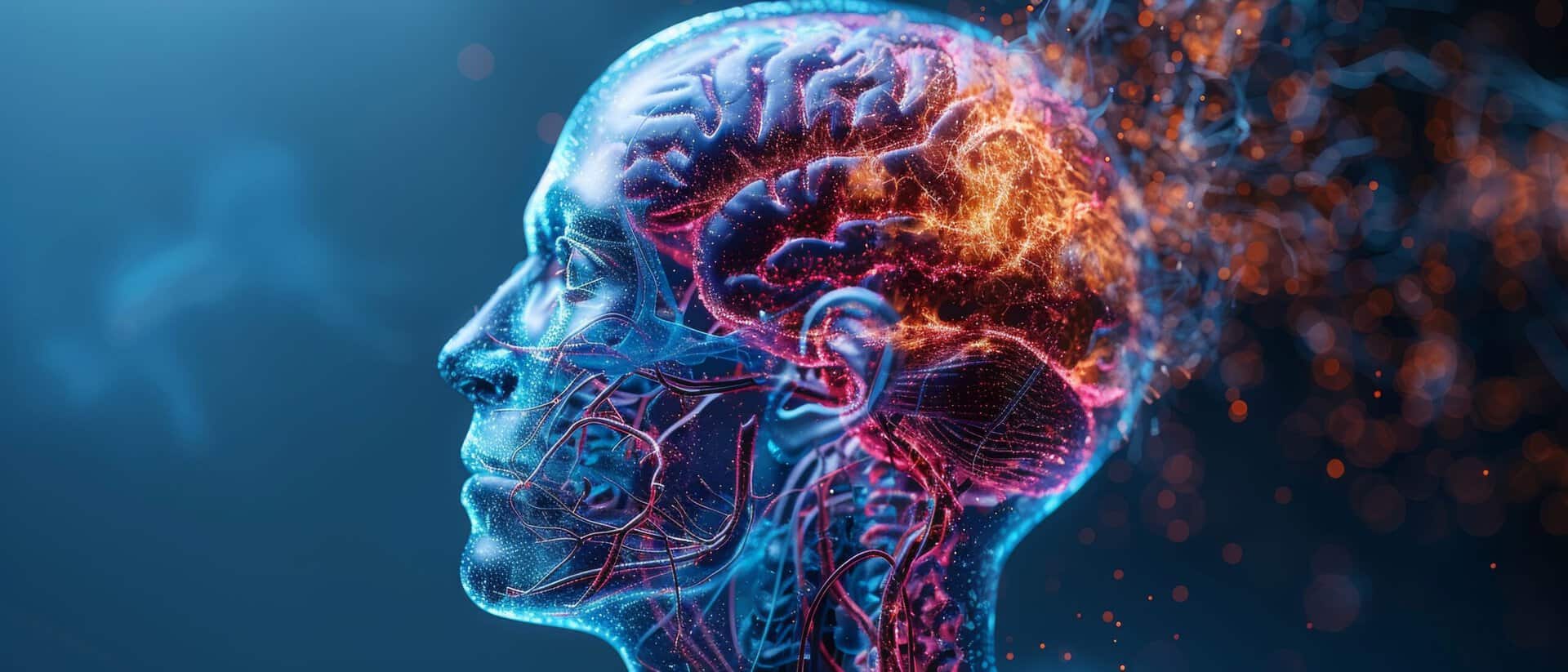What if there was a way to improve digestion, manage stress better, improve heart health, and boost your immune system? You’d be interested, right? That’s what stimulating the vagus nerve could help with.
The vagus nerve, often called the body’s communication superhighway, is an important part of the autonomic nervous system. It’s the longest cranial nerve in the body (cranial nerve number 10), running from the brain all the way down into the abdomen giving off branches along the way to important organs. It innervates multiple organs, impacting functions from heart rate and rhythm, breathing and digestion. The vagus nerve helps balance out the nervous system by regulating the fight or flight response and the rest and digest responses within the nervous system.
Understanding the vagus nerve’s vast role can provide insights into many aspects of health and well-being. But first, let’s learn a bit more about the autonomic nervous system.
Autonomic Nervous System
The autonomic nervous system is split into two branches:
- Sympathetic nervous system
- Parasympathetic nervous system.
The sympathetic nervous system is responsible for the “fight or flight” stress response. This is often what people associate with the nervous system. The sympathetic nervous system increases heart rate, alertness, and blood flow to the muscles. It’s what kicks in when you perceive danger, such as seeing a bear while hiking.
The parasympathetic nervous system is responsible for the “rest, relax and digest” response. It’s the calming alternative to the sympathetic nervous system. The parasympathetic nervous system decreases blood pressure, heart rate, alertness, and improves digestion. It helps with feelings of relaxation and calmness. The vagus nerve is part of the parasympathetic nervous system and helps calm the body after a stressful event.
When the vagus nerve is working properly, both branches of the autonomic nerve system are in balance. But when we’re stressed and anxious, this is often a sign that we’re out of balance and things aren’t working as well as they could be.
Vagus Nerve Anatomy
The vagus nerve is the tenth cranial nerve and is the longest cranial nerve in the body. It stretches from the brain to the abdomen. We actually have 2 vagal nerves–one on the right and one on the left. They contain motor fibers that innervate smooth muscle cells of several internal organs and blood vessels, including the lung, heart, gastrointestinal tract, liver, and pancreas. Because of the widespread reach, it’s often considered a vital communication link between the brain and the body.
The vagal nerves originates in the medulla oblongata in a part of the brain called the brainstem, that connects the brain to the spinal cord. As it moves from the brain to the abdomen, there are several branches along the way.
Each vagus nerve has four main branches in the neck:
- Pharyngeal branch, which innervates the pharyngeal and palate muscles.
- Superior laryngeal branch which innervates the larynx.
- Recurrent laryngeal branch, which supplies most of the laryngeal muscles.
- Superior cardiac nerve, which provides parasympathetic fibers to the heart.
In the thoracic cavity, the vagus nerve forms the anterior and posterior pulmonary plexuses and the esophageal plexus. It continues to give off gastric branches to the stomach and celiac branches to the kidneys, adrenals, pancreas, spleen, and small intestine.
Vagus Nerve Function
The vagus nerve is an essential part of the rest-and-digest response in the parasympathetic nervous system. It helps manage stress, reduce inflammation, regulate emotions, manage depression and anxiety, control headaches and migraines, and control heart rate and blood pressure. It also helps regulate the stomach and intestinal muscles, so food moves smoothly through the digestive tract – the “digest” part of the “rest-and-digest” function it’s known for. The vagal nerves also play an important role in regulating the immune system.
A discussion of vagus nerve function isn’t complete without an understanding of vagal tone. What is vagal tone? It’s a measure of how well the vagus nerve is functioning and refers to the activity of the vagus nerve. A higher vagal tone means a better ability to regulate stress.
How To Stimulate the Vagus Nerve: Vagus Nerve Stimulation
A well-functioning vagus nerve is essential for optimal health. When it’s not working as it should, numerous health issues can arise, including chronic inflammation, cardiac issues, and digestive disorders. Techniques such as meditation, deep breathing exercises, yoga, and other relaxation techniques like tai-chi, qi-gong, and acupuncture are great vagus nerve stimulation exercises, promoting relaxation and improving overall health. Research also explores the benefit of vagus nerve stimulation exercises in treating conditions like chronic pain, depression, and epilepsy.
Meditation, Deep Breathing, and Yoga
Meditation is a practice that involves focusing the mind to achieve a state of relaxation and mental clarity. Various forms of meditation, such as mindfulness meditation and deep breathing exercises can stimulate the vagus nerve. This vagus nerve stimulation exercise can help lower heart rate and reduce blood pressure.
Yoga, with its emphasis on breath control, mindfulness, and physical postures, naturally stimulates the vagus nerve. Practices like pranayama (breathing exercises) and asanas (yoga postures) can enhance vagal tone. Certain breathing techniques like Ujjayi breath (the ocean breath) and alternate nostril breathing are particularly effective. These practices encourage deep, slow breathing, which activates the parasympathetic nervous system.
Certain yoga poses can also aid in vagus nerve stimulation. Poses that involve gentle twists and inversions, such as the seated twist and the legs-up-the-wall pose, can enhance circulation and stimulate the vagus nerve. Additionally, restorative postures like the corpse pose promote deep relaxation and stress relief, further benefiting vagal tone.
Tai-chi and Qigong
Tai-chi is an ancient martial art practice that uses slow, gentle, and flowing movements with controlled breathing to promote health and rehabilitation. It’s similar to Qigong, which uses coordinated body postures, movement, breathing, and meditation techniques to improve health. The difference between the two lies in the emphasis on where the effort is placed – Qigong is often used for certain situations, such as to open the lungs for deeper breathing – whereas tai-chi focuses on the entire body. Both provide vagus nerve stimulation and activate the parasympathetic nervous system.
Acupuncture
Acupuncture is the practice of inserting tiny needles into specific points on the body to promote healing and balance. For vagus nerve stimulation, practitioners often focus on points located in the ear, neck, and abdomen. Ear acupuncture, or auricular acupuncture, targets points that correspond to the vagus nerve pathways. These techniques provide vagus nerve stimulation.
Vagus Nerve Stimulation Devices
Vagus nerve stimulation (VNS) is a technique that involves delivering electrical impulses to the vagus nerve. This can be done either through an implanted medical device under the skin or by less invasive methods such as non-invasive vagus nerve stimulation (nVNS). Another name for this is transcutaneous vagus nerve stimulation (tVNS). Vagus nerve stimulation has been used for many years to treat conditions like epilepsy, migraines, Parkinson’s disease, and depression by improving vagal tone. However, more recently, research studies are starting to support it’s use for many other symptoms and health conditions.
Non-invasive vagal nerve stimulation is an external device that provides painless electrical impulses through the skin to the vagus nerve. It’s often used at the ear (auricular vagus nerve branch) or the neck (cervical vagus nerve branch). The device is used daily for several minutes at a time. This removes the need for surgical implantation of a vagus nerve stimulation device and provides more convenient use.
Two examples of transcutaneous vagus nerve stimulation devices are Truvaga and gammaCore.
- Truvaga is a hand-held vagus nerve stimulator designed for stress, sleep, and mental health. I recommend the TruVaga Plus version.
- gammaCore is FDA approved to treat headaches, working to prevent and relieve headache pain.
When studied as a treatment option for pain, vagus nerve stimulation has shown pain-relieving or analgesic effects. It affects brain regions related to pain processing and has anti-inflammatory properties contributing to its pain-inhibitory effects.
Vagus Nerve Stimulation and Functional Medicine
The vagus nerve is a remarkable part of our nervous system, connecting the brain to various vital organs and influencing many bodily functions. Its role in maintaining homeostasis and promoting health cannot be overstated. By understanding and supporting the health of the vagus nerve, we can enhance our overall well-being and address various health challenges more effectively.
Functional medicine is a unique area of medicine that considers the vagus nerve when looking at symptoms and creating treatment plans. Unfortunately, not all providers do this. But at Arizona Wellness Medicine we do. We know that increasing vagal tone and stimulating the vagus nerve can have lasting health effects – which is why we incorporate it into treatment plans when appropriate. Contact us here to book your first appointment.
Resources:
- What is the vagus nerve?
- Gammacore
- Vagus Nerve Stimulation and the Cardiovascular System
- Neuroanatomy, Cranial Nerve 10 (Vagus Nerve)
- The anatomical basis for transcutaneous auricular vagus nerve stimulation
- Vagus Nerve Stimulation for the Treatment of Epilepsy
- Role of Vagus Nerve Stimulation in the Treatment of Chronic Pain
- Anatomy, Autonomic Nervous System









